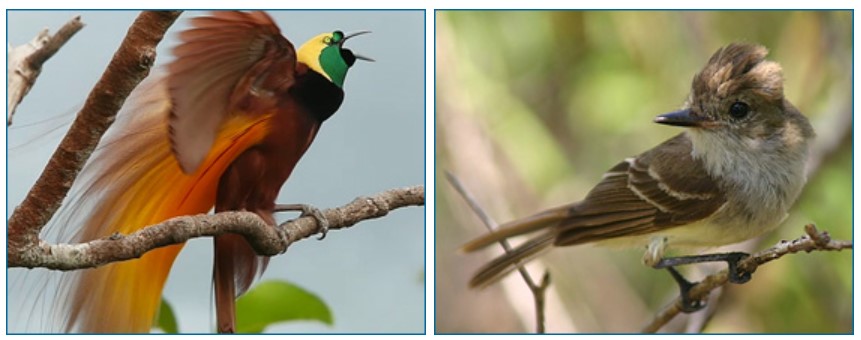Now that Kim has succeeded in understanding the evolutionary story behind the club-winged manakin’s singing wings and backwards dance, she wants to dig into the process that made this strangeness possible: sexual selection. Male manakins spend an enormous proportion of their time and energy displaying and courting females, and they don’t provide parental care or build nests. Furthermore, in species like the club-winged manakin, elaborate anatomical and physiological modifications have evolved that allow them to perform their turbo-charged mating rituals. While these traits are valuable — the equivalent of a killer pick up line — they are likely detrimental to the bird in other ways. For example, male club-winged manakins have solid wing bones instead of light-weight hollow ones, as most birds do. Solid bones allow the bird to produce its distinctive wing noise, but make flying much more energetically expensive, so there is a trade-off between reproductive advantage and energetic efficiency.

Kim is interested in this balance between natural selection and sexual selection. To understand what trade-offs occurred in the evolution of manakin wings and displays, she will need to carry out detailed physiological studies of the birds, as well as fieldwork to examine what fitness benefits might accrue from different traits. As Kim puts it, “There’s a lot we don’t understand about what’s possible in an organism. And one of the great things about sexual selection is that it’s sort of liberating: whatever idiosyncratic thing the female goes for can be selected for. This allows the organism to explore morphological and physiological worlds that they won’t be selected to explore through natural selection alone.”
Male manakins spend all day hanging out with other males in leks, waiting for females to stop by. Male bowerbirds focus their energy on building architecturally complex stages on which they perform for females. Male birds of paradise have knock-out plumage, putting their displays — which they perform even when females are not around — truly over the top. Yet after all that work to father a chick, none of these male birds provides any parental care to its offspring: after mating, it focuses its attentions on the next female to come along. The comparatively drab male flycatcher, on the other hand, not only stays with the female after mating and helps feed the chicks alongside her, but will raise a new family with the same mate year after year. Why the difference? Why do males of some species mate with one or a few females and provide significant help raising young, while in other species males focus on breeding with as many females as possible and ignore the young? Many factors certainly contribute to the evolution of one mating system or the other, but some scientists have hypothesized that diet may be important. Flycatchers, as their name suggests, eat mostly insects, while manakins, bowerbirds, and birds of paradise specialize in eating fruit that is available year round. Insects can be hard to come by and must be hunted down; whereas fruit is, in a sense, there to be eaten. Fruit is a plant’s approach to distributing its seeds, and many plants evolved in ways that facilitate seed distribution by making their fruit plentiful and easy to eat. Making an evolutionary switch from eating insects to eating fruit may promote the evolution of polygyny (males mating with multiple females) in birds because a fruit-eating female may be capable of providing sufficient sustenance to her offspring on her own, whereas an insect-eating female’s chicks may be more likely to die if she does not have help from another bird.

2Snow, D.W. 1971. Evolutionary aspects of fruit-eating by birds. Ibis 113:194-202.
